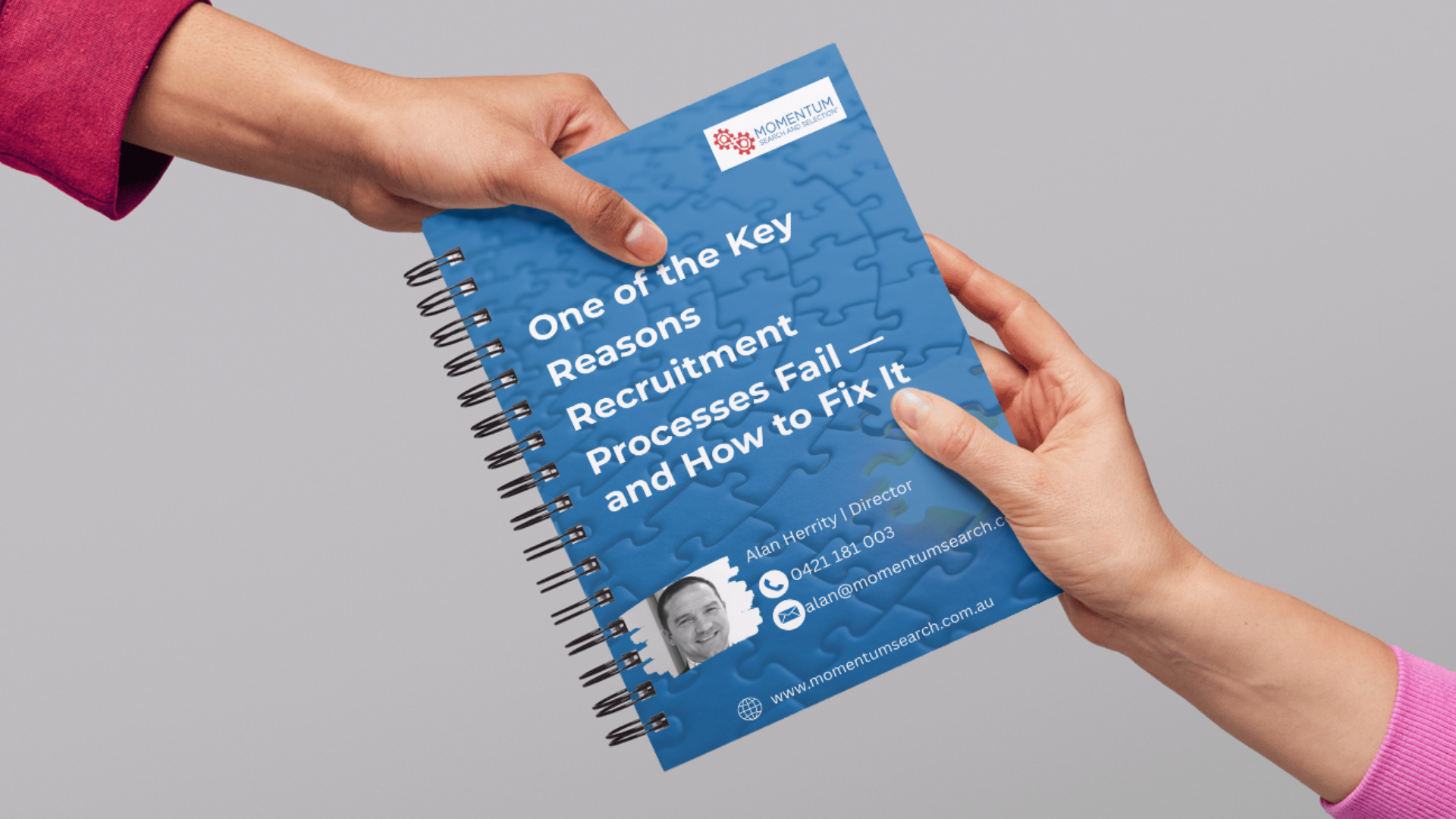Alan Herrity | August 4, 2025

Why the briefing meeting is the most under-leveraged step in hiring — and what top-performing organisations do differently.
It may look like a simple meeting, but in my experience, the briefing is where success begins or quietly starts to unravel.
At Momentum Search and Selection, we’ve seen it firsthand: misaligned stakeholders, lengthy delays, and disengaged candidates all traced back to a rushed or vague briefing meeting. The reality? In a search, failure rarely starts from poor CVs or bad interviews. It begins well before that. If stakeholders aren’t aligned, something is likely to go wrong and usually does. A rushed or vague briefing almost guarantees missteps later, and they’re often costly.
The solution? A thorough, strategic briefing that sets the direction of the entire process.
Why Briefing Meetings Matter
Whether you're hiring a Chief Digital Officer, Program Director, or Head of Change, the briefing meeting isn’t just an administrative kick-off; it’s a must-do alignment session.
“It’s where we align every element of the brief, from industry-specific skills and behavioural traits to target companies and compensation. If we don’t get this right upfront, something is likely to go wrong and usually does. We partner with our clients to solve these challenges. The briefing meeting sets the direction for the entire search."
A strong briefing meeting ensures:
- A clear, compelling story of the role and its impact.
- Agreement on success criteria and hiring outcomes.
- Alignment on both functional and behavioural competencies.
- Early identification of roadblocks or sensitivities, such as companies not to approach.
- A strategic partnership that saves time later in the process.
When this step is undervalued or skipped, the consequences ripple fast: vague shortlists, candidate dropouts, stakeholder friction — and ultimately, a failed or delayed appointment.
What a Best-in-Class Briefing Looks Like
Personally, I won’t run a search without a full, strategic briefing. It’s that foundational.
We use a proven structured diagnostic process to uncover the real drivers behind the hire, followed by a briefing framework that aligns stakeholders on every front. It helps answer critical questions such as:
- Why is this role business-critical right now?
- What are the three to five outcomes this person must deliver in the role?
- What does a top-performing candidate want to know before they engage?
- Which companies and candidates are off-limits — and which are targets?
- How do we craft an EVP that speaks to passive, in-demand talent?
“We recently placed a Head of Technology after the client had tried and failed with another agency. The difference? We invested time up front, with a proper diagnostic and a detailed briefing meeting. That’s what made the outcome faster and stronger.”
The process also includes:
- Cultural and organisational context.
- Clarity on compensation and progression.
- Agreement on off-limits companies, discreet targets, and talent pools to avoid reputational risk.
- Planning for candidate engagement and search milestones.
- Ongoing market intelligence, salary benchmarks, competitive positioning, and diversity trends.
It’s how we ensure every candidate conversation reflects the true opportunity, not just the job spec.
The Commercial Case for Getting It Right
Briefing meetings aren’t just about alignment; they deliver clear commercial value for senior decision-makers:
- Managing Directors and CEOs gain speed and precision in hiring aligned to strategic outcomes.
- Chief People Officers secure culturally aligned hires with long-term potential.
- Program and Delivery leaders avoid costly mid-search pivots by scoping success early.
- CDOs and CIOs engage niche talent with sharper messaging and better market context.
“It’s an investment. One proper briefing meeting saves hours later. If it’s skipped, you’re likely to waste time, lose candidates, or hire the wrong person.”
What Candidates Notice — and Why It Matters
A well-run briefing doesn’t just benefit the client. It also shapes a better candidate experience.
“When we can articulate the EVP, team dynamics, leadership style, visibility of the role, and exciting initiatives, candidates light up. A proper briefing gives us the depth to tell the right story.”
Without this, candidate interest fades. With it, engagement deepens.
Briefings Are Evolving — and Getting Smarter
As recruitment becomes more data-led and AI-powered, briefing meetings now include insights on:
- Competitive talent flows (who’s losing talent to whom).
- Emerging job titles and skills.
- Diversity benchmarks.
- Real-time salary data by industry, geography, and company size.
This data helps clients understand where they stand and what it will take to compete in a changing market.
Explore how we apply a data-driven approach to diversity in recruitment.
“It’s not just salary benchmarks; it’s also knowing which competitors are losing talent, emerging job titles, and diversity insights. These are already part of how we inform clients and shape smarter searches.”
Momentum’s Perspective
We treat briefing meetings as the launchpad for every successful hire. It’s where strategy, messaging, and alignment are forged, and where we set a smart pace for the rest of the search.
“It’s not just about filling a role; it’s about building the right partnership from the start. That’s how we deliver results that last.”
Final Thought: Invest at the Start to Win Later
A strong hire begins with a strong brief.
For critical roles, where every week counts and missteps are costly, the briefing meeting isn’t optional. It’s the difference between a successful search or a stalled and potentially costly outcome.
Looking to secure senior talent that delivers impact from day one? Contact Alan Herrity at alan@momentumsearch.com.au
Alan Herrity
Director
Momentum Search and Selection










